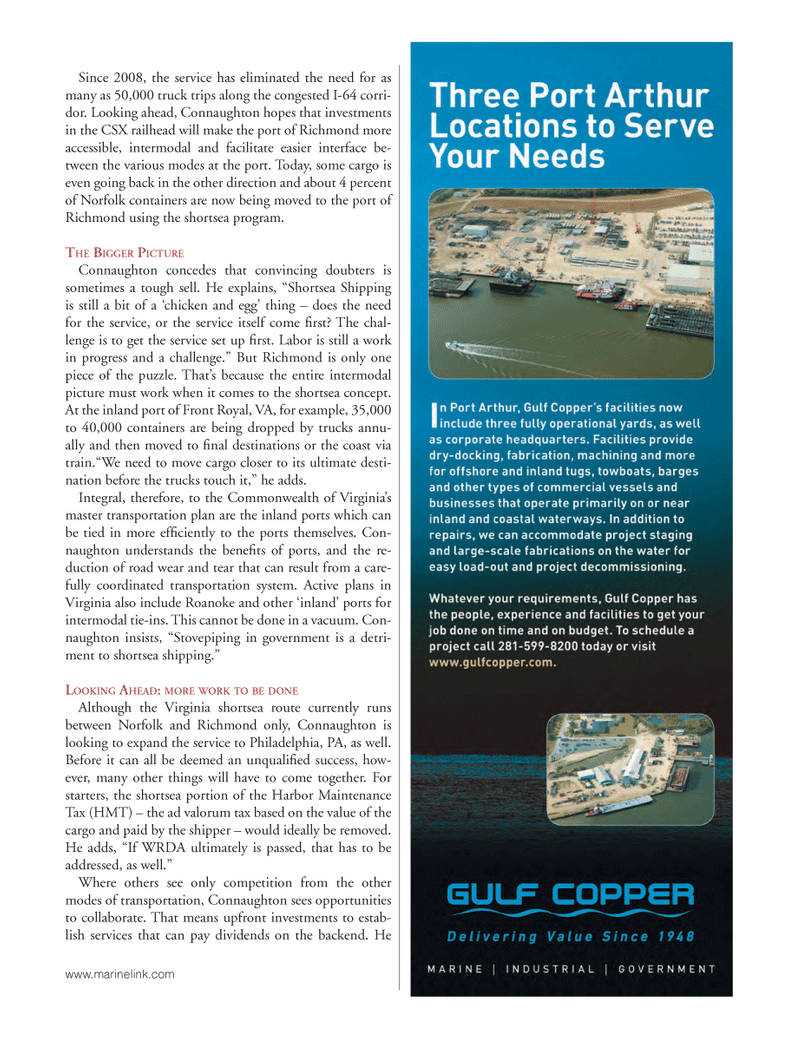
Page 19: of Marine News Magazine (June 2013)
Dredging & Marine Construction
Read this page in Pdf, Flash or Html5 edition of June 2013 Marine News Magazine
Since 2008, the service has eliminated the need for as many as 50,000 truck trips along the congested I-64 corri- dor. Looking ahead, Connaughton hopes that investments in the CSX railhead will make the port of Richmond more accessible, intermodal and facilitate easier interface be- tween the various modes at the port. Today, some cargo is even going back in the other direction and about 4 percent of Norfolk containers are now being moved to the port of Richmond using the shortsea program. THE BIGGER PICTUREConnaughton concedes that convincing doubters is sometimes a tough sell. He explains, ?Shortsea Shipping is still a bit of a ?chicken and egg? thing ? does the need for the service, or the service itself come rst? The chal- lenge is to get the service set up rst. Labor is still a work in progress and a challenge.? But Richmond is only one piece of the puzzle. That?s because the entire intermodal picture must work when it comes to the shortsea concept. At the inland port of Front Royal, VA, for example, 35,000 to 40,000 containers are being dropped by trucks annu- ally and then moved to nal destinations or the coast via train.?We need to move cargo closer to its ultimate desti- nation before the trucks touch it,? he adds. Integral, therefore, to the Commonwealth of Virginia?s master transportation plan are the inland ports which can be tied in more ef ciently to the ports themselves. Con- naughton understands the bene ts of ports, and the re- duction of road wear and tear that can result from a care- fully coordinated transportation system. Active plans in Virginia also include Roanoke and other ?inland? ports for intermodal tie-ins. This cannot be done in a vacuum. Con- naughton insists, ?Stovepiping in government is a detri- ment to shortsea shipping.? LOOKING AHEAD: MORE WORK TO BE DONEAlthough the Virginia shortsea route currently runs between Norfolk and Richmond only, Connaughton is looking to expand the service to Philadelphia, PA, as well. Before it can all be deemed an unquali ed success, how- ever, many other things will have to come together. For starters, the shortsea portion of the Harbor Maintenance Tax (HMT) ? the ad valorum tax based on the value of the cargo and paid by the shipper ? would ideally be removed. He adds, ?If WRDA ultimately is passed, that has to be addressed, as well.? Where others see only competition from the other modes of transportation, Connaughton sees opportunities to collaborate. That means upfront investments to estab- lish services that can pay dividends on the backend. He www.marinelink.com MN June2013 Layout 18-31.indd 19MN June2013 Layout 18-31.indd 195/30/2013 11:07:21 AM5/30/2013 11:07:21 AM

 18
18

 20
20
